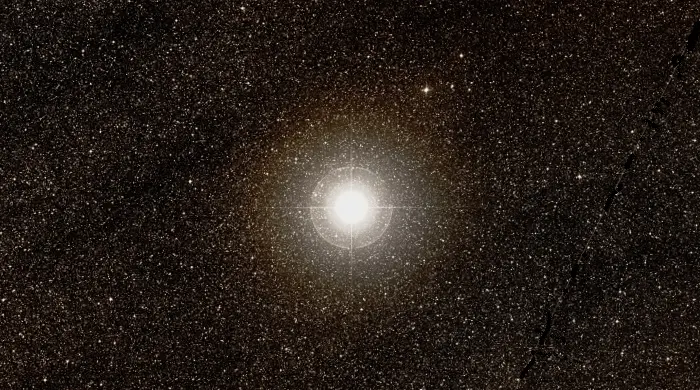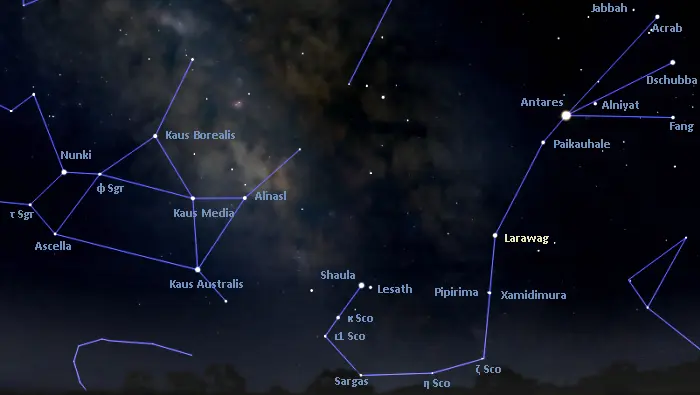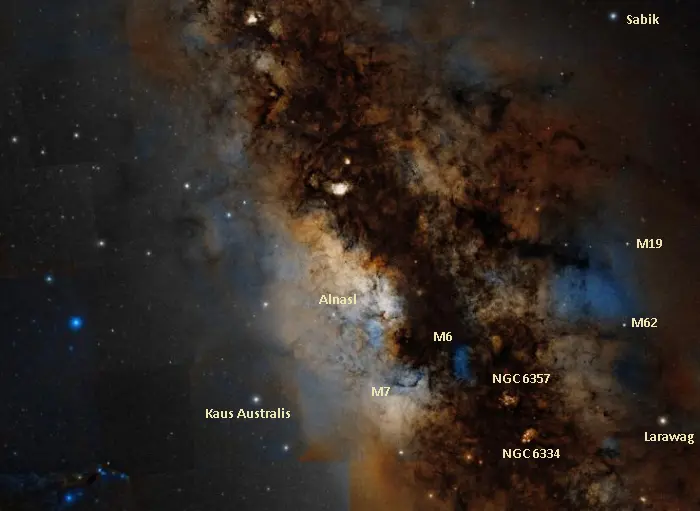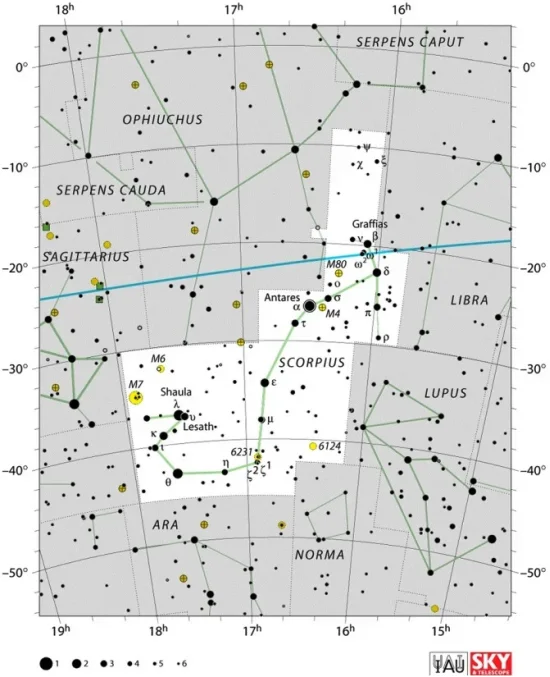Larawag, Epsilon Scorpii (ε Sco) is a K-type giant star located 63.7 light-years away in the constellation Scorpius. With an apparent magnitude of 2.310, it is the fifth brightest star in Scorpius, after Antares, Shaula, Sargas, and Dschubba. Larawag is one of the bright Scorpius stars that form the Fish Hook, an asterism that outlines the celestial Scorpion’s body, tail and stinger.
Star type
Larawag is an orange giant star of the spectral type K1 III. It has a mass of 1.24 solar masses and a radius 12.6 times that of the Sun. With an effective temperature of 4,560 K, the giant has the orange hue of a K-type star. It spins at about 2.6 km/s.
Larawag is a red clump giant, a cool star on the horizontal branch which has undergone a helium flash and is now burning helium in its core. It is not massive enough to go out as a supernova when it reaches the end of its life cycle. Instead, it will expel its outer layers to form a planetary nebula and slowly fade away as a white dwarf.

Larawag (Epsilon Scorpii), image: Wikisky
The star is a suspected variable. Its brightness has been reported to vary from magnitude 2.24 to 2.35. However, photometric data obtained by the Hipparcos satellite has revealed a variation of only up to 0.01-0.02 magnitudes.
Larawag is a known X-ray source. It has a luminosity of (1.5–1.6) × 1027 erg s−1.
Facts
Larawag forms an asterism known as the Fish Hook with Alniyat (Sigma Scorpii), Antares (Alpha Scorpii), Paikauhale (Tau Scorpii), Xamidimura and Pipirima (Mu1 and Mu2 Scorpii), Zeta Scorpii, Eta Scorpii, Sargas (Theta Scorpii), Iota1 Scorpii, Kappa Scorpii, and Shaula (Lambda Scorpii). The asterism is easily visible even from light-polluted areas.
Larawag is one of the stars that are represented on the flag of Brazil. Each star represents a Brazilian Federal Unit and Larawag symbolizes the state of Ceará. Other Scorpius stars on the Brazilian flag are Antares, Acrab, Sargas, Iota Scorpii, Kappa Scorpii, Shaula, Xamidimura and Pipirima.
Name
The name Larawag (pronunciation: /ˈlærəwæɡ/) is the traditional name of Epsilon Scorpii in the lore of the Wardaman people in the Northern Territory of Australia. It means “clear sighting.” The name is associated with a Wardaman traditional initiation ceremony. Several bright stars in Scorpius represent different people involved in the ceremony. Larawag is associated with the signal watcher, the person who gives the signal for the secret part of the ceremony to begin.
The name Larawag was approved by the International Astronomical Union’s (IAU) Working Group on Star Names (WGSN) on November 19, 2017.
In Chinese astronomy, Epsilon Scorpii was known as 尾宿二 (Wěi Xiù èr), the Second Star of Tail. It formed the Tail asterism with Xamidimura (Mu1 Scorpii), Zeta1 Scorpii, Zeta2 Scorpii, Eta Scorpii, Sargas (Theta Scorpii), Iota2 Scorpii, Iota1 Scorpii, Kappa Scorpii, Shaula (Lambda Scorpii), and Lesath (Upsilon Scorpii). The asterism was part of the Tail mansion, which represented the tail of the Azure Dragon.
Location
Larawag is very easy to find because it is part of the Fish Hook of Scorpius and it lies near Antares, one of the brightest stars in the sky. It is the second relatively bright star south-southeast of Antares, after Paikauhale (Tau Scorpii). It lies roughly halfway between Antares and the curve of the Scorpion’s tail.

The location of Larawag in Scorpius, image: Stellarium
Larawag can be used to find several notable deep sky objects that appear in the same area of the sky. The globular cluster Messier 62 in the constellation Ophiuchus appears 4.75 degrees northeast of the star. Its neighbour Messier 19 can be found just a little less than halfway along the imaginary line from Larawag to Sabik (Eta Ophiuchi).

The deep sky objects appearing near Larawag, image: Wikisky
The bright open cluster Messier 6 (the Butterfly Cluster) lies about two thirds of the way from Larawag to Alnasl, the star that marks the tip of the Teapot’s spout in Sagittarius. The cluster appears near Shaula at the Scorpion’s stinger. The nearby Messier 7 (the Ptolemy Cluster) appears about two thirds of the way from Larawag to Kaus Australis, the brightest star in Sagittarius.
The nebulae NGC 6357, also known as the War and Peace Nebula or Lobster Nebula, and NGC 6334, nicknamed the Cat’s Paw Nebula or Bear Claw Nebula, appear in the same area of the sky.
Constellation
Larawag is located in the constellation Scorpius. The celestial Scorpion is one of the most recognizable constellations in the night sky. Its brightest stars outline its claws, body, tail, and stinger. The red supergiant Antares, the 15th brightest star in the sky, marks the Scorpion’s heart.
Scorpius is one of the 48 ancient Greek constellations listed by the Greco-Roman astronomer Claudius Ptolemy in his Almagest in the 2nd century CE. Stretching across 497 square degrees of the southern sky near the Milky Way’s band, it is the 33rd largest constellation in the sky. In Greek mythology, Scorpius is associated with the scorpion that stung Orion.

Scorpius constellation map by IAU and Sky&Telescope magazine
Scorpius hosts many notable stars. In addition to Antares, these include the multiple star systems Lambda Scorpii (Shaula), Delta Scorpii (Dschubba), Beta Scorpii (Acrab), Pi Scorpii (Fang), and Sigma Scorpii (Alniyat), the binary systems Theta Scorpii (Sargas) and Kappa Scorpii, the class F supergiant Iota1 Scorpii and A-type supergiant Iota2 Scorpii, the blue subgiant Lesath (Upsilon Scorpii), and the recurring nova U Scorpii.
Bright deep sky objects in Scorpius include the Messier open clusters M6 (the Butterfly Cluster) and M7 (the Ptolemy Cluster), the open clusters NGC 6231 (the Northern Jewel Box) and NGC 6821, the star-forming nebulae NGC 6357 (the Lobster Nebula or War and Peace Nebula) and NGC 6334 (the Cat’s Paw Nebula or Bear Claw Nebula), the reflection nebula IC 4592 (the Blue Horsehead), the planetary nebula NGC 6302 (the Butterfly Nebula), and the globular clusters Messier 4 and Messier 80.
The best time of the year to observe the stars and deep sky objects in Scorpius is during the month of July, when the constellation climbs high above the horizon in the evening. The entire constellation is visible from locations south of the latitude 40° N.
The 10 brightest stars in Scorpius are Antares (Alpha Sco A, mag. 0.6 – 1.6), Shaula (Lambda Sco A, mag. 1.62), Sargas (Theta Sco A, mag. 1.84), Dschubba (Delta Sco, mag 2.307), Larawag (Epsilon Sco, mag. 2.31), Kappa Scorpii (mag. 2.39), Acrab (Beta Sco, mag. 2.62), Lesath (Upsilon Sco, mag. 2.70), Paikauhale (Tau Sco, mag. 2.82), and Fang (Pi Sco, mag. 2.89).
Larawag – Epsilon Scorpii
| Spectral class | K1 III |
| Variable type | Suspected |
| U-B colour index | +1.147 |
| B-V colour index | +1.150 |
| Apparent magnitude | 2.310 (2.24 – 2.35) |
| Absolute magnitude | 0.78 ± 0.04 |
| Distance | 63.7 ± 0.3 light-years (19.54 ± 0.08 parsecs) |
| Angular size | 5.99 ± 0.06 mas |
| Parallax | 51.19 ± 0.22 mas |
| Radial velocity | –2.5 ± 0.5 km/s |
| Proper motion | RA: –614.85 ± 0.21 mas/yr |
| Dec.: –255.98 ± 0.13 mas/yr | |
| Mass | 1.24 M☉ |
| Radius | 12.6 R☉ |
| Temperature | 4,560 K |
| Metallicity | –0.17 dex |
| Rotational velocity | 2.6 ± 0.5 km/s |
| Surface gravity | 2.49 cgs |
| Constellation | Scorpius |
| Right ascension | 16h 50m 09.8108127s |
| Declination | –34° 17′ 35.633735″ |
| Names and designations | Larawag, Epsilon Scorpii, ε Sco, 26 Scorpii, Wei, HD 151680, HR 6241, HIP 82396, FK5 628, SAO 208078, CD–34 11285, CPD-34 6635, Gl 639.1, GCTP 3823.00, LHS 3244, GC 22640, GCRV 9669, PPM 295532, LFT 1303, LPM 620, LTT 6711, NLTT 43615, NSV 7983, JP11 2790, IRAS 16469-3412, 2MASS J16500982-3417355, UBV 14234, TYC 7367-804-1, Gaia DR3 6026152137856166912 |